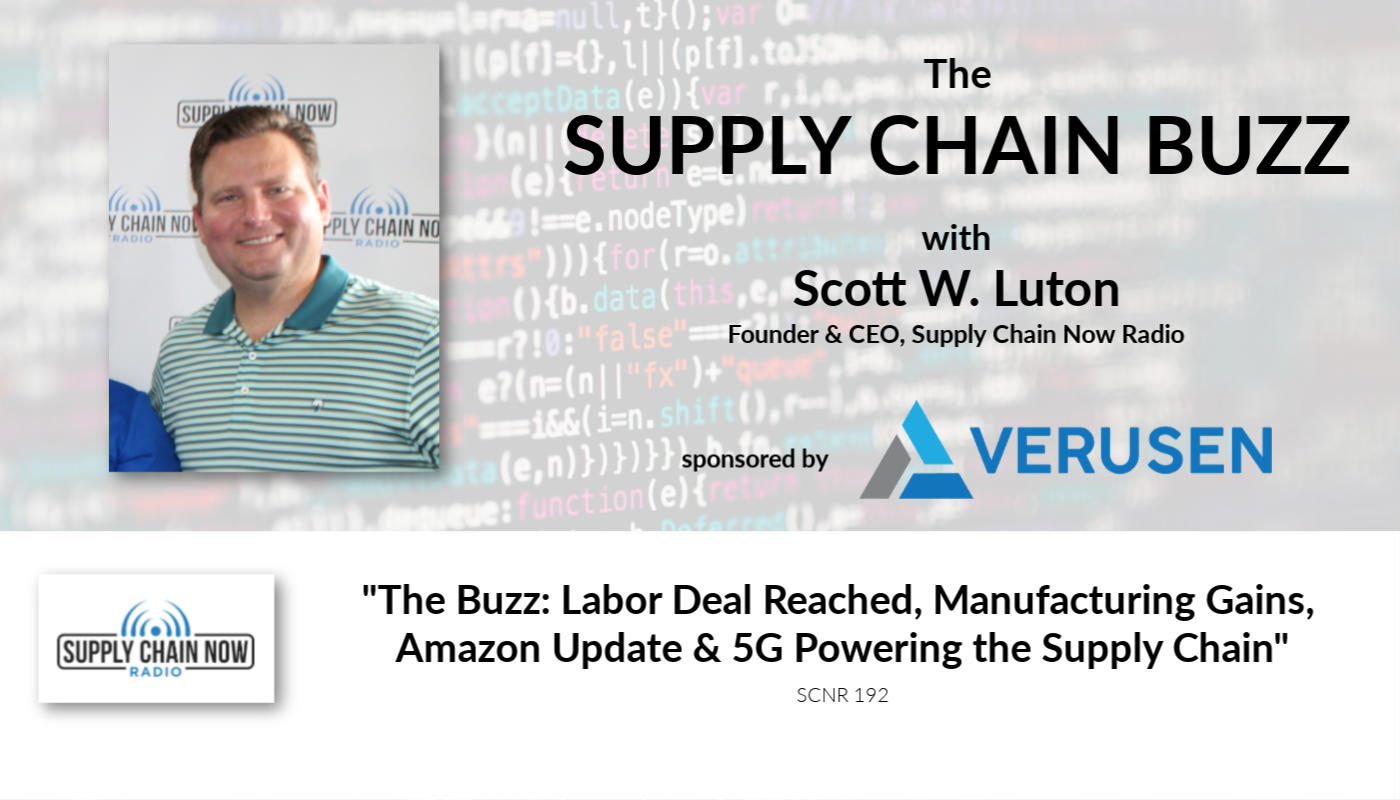Supply Chain Now Radio Episode 192

Supply Chain Now Radio, Episode 192
The Supply Chain Buzz Series
Sponsored by Verusen: www.verusen.com/

In this episode of the Supply Chain Buzz, Scott Luton discusses the latest topics in supply chain- labor deals, manufacturing gains, Amazon, 5G, and more!
[00:00:09] Good morning, Scott Luton here with you live on Supply Chain Now Radio, welcome to the show. In today’s show, we’re continuing our Supply chain Bus series, a brief weekly look at some of the top news and trends across the global India in Supply chain community. All in 15 minutes or less. Today’s episode of the Supply chain Buzz on Supply Chain Now Radio is brought to you by Verusen, an innovator in materials, inventory and data management technology.
[00:00:39] Pearsons Cloud Platform uses artificial intelligence to harmonize and provide visibility into materials, inventory data from ERP and many other systems. Learn more at Verusen dot com v e r u s e n dot com. It’s Monday, October 28. Before we tackle our news today on Joyed, the opportunity of spending time in two iconic American cities here in the last week, New Orleans, Louisiana, and Charleston, South Carolina. Both cities, of course, are supply chain centers and the global economy, especially with their robust seaports. The port in New Orleans generates nearly one hundred twenty thousand jobs and 30 billion dollars of economic output nationally. The immense levels of commodities that are moved annually at the Port New Orleans allow for six hundred sixty million chicken pot paths to be served, one point sixty five million still boarded automobiles to be manufactured. And of course, what powers? A global supply chain industry $20 billion cups of coffee to be brewed, all provided for by what is moved annually at the poor New Orleans. Equally as impressive, the South Carolina Ports Authority, headquartered in Mount Pleasant, South Carolina, which lies just across the Cooper River from Charleston, is responsible for one in 10 jobs in the state and a whopping sixty three point four billion dollars in and an economic impact in the state of South Carolina. What is its number one export? You ask for calendar year 2018.
[00:02:14] Well, that would be paper and paperboard and its number one import. That would be automotive parts by far. One last note about Charleston Harbor. A deepening project is currently underway that will make it the deepest harbor on the East Coast, which would enable the port to serve 20 post-Panamax vessel calls each and every week. I thoroughly enjoyed our travels through both cities, especially, as you might imagine, the incredible food and fascinating people. Now let’s get to the news. First, we have some good news we can all use good news, right, as reported by The Wall Street Journal. The United Auto Workers is ending its nationwide strike that has impacted forty six thousand workers and their families, as well as more than 30 GM factories. A new deal has been struck between the UAW and GM. That includes better wages for the workers, signing bonuses for the workers, a commitment from General Motors to invest seven point seven billion dollars in its U.S. manufacturing operations. This reportedly is aimed at securing 9000 jobs here in the states. The four year deal also allows GM to move Ford in its plan to close three U.S. factories, including a large assembly plant in Lordstown, Ohio, a small community about 61 miles southeast of Cleveland. Job one for the UAW and GM will be getting the workers back to work A.S.A.P.
[00:03:46] and get all the impacted plants back up and running. GM expects to make that happen by early next week, but the financial toll that the longest nationwide strike in almost 50 years has had on the company. General Motors will continue to linger. Bank of America projects that it has cost the company three billion dollars, most coming in fourth quarter. Additionally, some estimate that the agreement will add one hundred main dollars or more and higher labor costs per year moving forward. Across the picket line, workers have also paid dearly for their activism. Most did not receive a company check for six weeks, depending on modest unit union benefits or other sources of income to make ends meet in the weeks and months ahead. UAW turns its attention to other automotive companies. And we’ll look at replicating its success at the negotiating table. Ford Motor Company is up next. And it has even more UAW represents workers. Some 56000 Ford employees are represented by the union. In our second story here on Supply chain, Buzz. Supply Chain Now Radio. We continue to provide some good news to you, our listeners. According to Bloomberg and via our friends at Industry Week, U.S. factory activity surprised many by improving in October for a second month in a row. The HIMSS Market Manufacturing Purchasing Managers Index hit fifty one point one in September and then rose to fifty one point five and a prelim October reading and you’re reading over 50 projects expansion, expansion in the sector.
[00:05:31] But looking at the same index and other parts of the world, the projection wasn’t nearly as rosy. Japan had the weakest measurement in more than three years. Europe mostly remained unchanged. Germany’s October numbers. Well, it didn’t change much the country. The country’s September reading represents the biggest downturn in manufacturing activity since June 2009. Also tempering the optimism, U.S. factories received less orders for business equipment for a second straight month. Freight activity has generally declined. And there are still plenty of concerns, as we all know, about U.S. China trade tensions. And our third story here on The Buzz, everyone is paying more for shipping these days, right? Including one of the global e-commerce leaders, Amazon. According to an article by Dana Mattioli in The Wall Street Journal. Amazon shipping costs are up 46 percent for third quarter twenty nineteen when compared to third quarter last year. The company spent a whopping Lu, non-point six billion dollars on shipping during July, August and September. Twenty nineteen. And that’s had a big impact, as you might would imagine. On its profitability, Amazon reported last week that its third quarter profit was down 26 percent percent from the same time period in twenty eighteen.
[00:06:55] That’s the first profit decline since twenty seventeen for the company. Spending on operations and infrastructure is also up and Amazon as a company continues to build out next day’s shipping capabilities for its prime customers. Shipping and infrastructure costs aren’t the only things to have increased. Amazon. The company is spending more money on talent. Third quarter twenty nineteen brought a considerable hiring increase as Amazon can now proudly boast an Amazon army of over seven hundred and fifty thousand professionals that make up the organization. Amazon Web Services reported incredible growth year over year. But at a slightly slower clip, this while one of its primary competitors in the cloud but in the cloud business, Microsoft reported a record breaking third quarter for its cloud services unit. OK. Our fourth story, we’re talking about 5G and its impact on the Supply chain world. In a neat article published on Supply chain divx, Gary Wall and Hopp talks about some of the ramifications of the 5G mobile broadband standard that is being rolled out in markets globally. Gartner published a recent survey that stated 66 percent of organisations plan to deploy 5G, the fifth the fifth generation of cellular network technology by 2020. At the same time, Gartner predicts most cell service providers won’t complete an end in implementation of 5G on their public networks until around 2025 the 2030.
[00:08:32] So what are some of the main inpublic implications of 5G on SUPPLY CHAIN? This article cites for first track and trace visibility is expected to be a major area of improvement in SUPPLY CHAIN Logistics better 5G enable devices will be available at a lower cost. Companies will be much more able to track components in a multitude of ways. Does it and does your company require a high degree of synchronization? Then you will absolutely love 5G. The second big impact of 5G on supply chains, according to the article, is product monitoring. 5G bandwidth will allow for network slicing capabilities, providing much more detailed insights. Bleek US Antalya Vise president and consultant at 80. Kearney says, quote, With the technology available today, you can measure the condition of the product at the vehicle level, but you can’t monitor at the product level. 5G allows you to monitor at the SKU level so you have more detailed knowledge of what condition your product is in, where it is and when it’s going to get to your customer endquote. Impact number three of five G on supply chains is much better connectivity, indoor and outdoors. Not only is 5G offer better penetration into buildings, but the technology can also serve as a bridge for mobile clinic for mobile communications such as LTM, 4G and Wi-Fi. Sally Miller, CIO for DHL Supply chain, says, quote, We can start imagining seamless transitions and network connectivity from inside the warehouse to the outside, transportation, end quote.
[00:10:17] And finally, impact number four, five Geon supply chains. Even better, Real-Time data with five GS reduced latency. There’s even less lag time from the time a sensor detects a signal and when it’s recognized by the system, this will power a variety up of applications and provide better and faster decision making, especially automation and robotics. Are you ready? If not, get ready. 5G is coming to a SUPPLY CHAIN near you very soon. Or maybe it already has. And that’s a wrap for today’s episode. Several of the leading Supply chain news stories and trends right here on the Supply chain Buzz on Supply Chain Now Radio. You’ll find links to each of the four stories on the show, notes for your convenience, including a few other additional resources. And I hope you’ve been able to check out the Supply chain Pulse. Our new redesigned newsletter, Full of Resources. If you’re interested in getting subscribe to our monthly newsletter, shoot us a note to connect at Supply Chain Now Radio dot com. We’ll get you hooked up. Big thanks to today’s sponsor of the Supply chain Buzz. Verusen. And to our listeners. On behalf of the entire Supply Chain Now Radio team, this is Scott Luton.
[00:11:40] Thank you for joining us and we wish you a very successful week. Thanks, Robert.
Upcoming Events & Resources Mentioned in this Episode:
UAW and GM Agree to Labor Deal: https://tinyurl.com/y4ktwfgy
U.S. Manufacturing Update: https://tinyurl.com/y3o533zt
Amazon Update: https://tinyurl.com/y34yvfq5
What 5G Means for Supply Chain: https://tinyurl.com/y2f9wqfz
Connect with Scott on LinkedIn: https://www.linkedin.com/in/scottwindonluton/
eft Logistics CIO Forum in Austin, TX: https://tinyurl.com/y5po7tvw
SCNR to Broadcast Live at CSCMP Atlanta Roundtable Event: https://tinyurl.com/y43lywrd
Reverse Logistics Association Conference & Expo: https://rla.org/calendar/1
SCNR to Broadcast Live at MODEX 2020: https://www.modexshow.com/
2020 Atlanta Supply Chain Awards: https://www.atlantasupplychainawards.com/
SCNR on YouTube: https://tinyurl.com/scnr-youtube
The Latest Issue of the Supply Chain Pulse: https://tinyurl.com/y6rv76ss
Check Out News From Our Sponsors
The Effective Syndicate: https://www.theeffectivesyndicate.com/blog
Spend Management Experts: https://spendmanagementexperts.com/
APICS Atlanta: https://apicsatlanta.org
TalentStream: https://talentstreamstaffing.com/
Verusen: https://www.verusen.com/
Georgia Manufacturing Alliance: https://www.georgiamanufacturingalliance.com/
ProPurchaser.com: https://tinyurl.com/y6l2kh7g
Supply Chain Real Estate: https://supplychainrealestate.com/
Vector Global Logistics: http://vectorgl.com/





